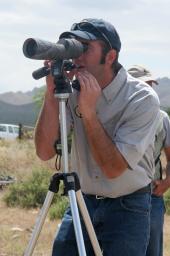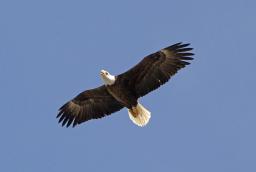Slug: BC-CNS-Bald Eagles,355
Photos available (thumbnails, captions below)
By CHRISTINE HARVEY
Cronkite News Service
APACHE JUNCTION (Wednesday, April 21)_ The number of bald eagles hatched this season will decrease with fewer pairs breeding due to the harsh winter, a state wildlife official said Wednesday.
“If we have a mellow spring and summer, most of the nestlings will probably make it, but it’s not going to be a record year,” said Kenneth “Tuk” Jacobson, bald eagle coordinator for the Arizona Game and Fish Department.
This season, 51 of 61 breeding sites are occupied, but not all pairs have decided to nest, in part because heavy winter rains created deeper, muddier waterways that made it more difficult for the eagles to catch fish, he said.
Jacobson and other officials took reporters to see a site along the Salt River where crews are keeping an eye on nests as part of the Bald Eagle Nestwatch Program. Their goal: Keeping people from disturbing the eagles.
Ernie O’Toole, one of 20 nestwatch members, said the pair he is watching in the Goldfield breeding area began nesting late in the breeding season. Their young hatched last week.
“My fear is that as they grow older, they are pretty vulnerable to the heat. It’s getting later in the season and if the parents leave the nest, the nestling could get snatched, dehydrate or be disturbed,” he said.
Jean Spilker, O’Toole’s partner in watching the nest, said her biggest concern is ignorance among the public.
“People need to be aware of the effect their actions have on the environment. Leaving your fishing lines, throwing garbage or even being too loud can have a much more profound effect on these birds than people realize,” she said.
The bald eagle was removed from the federal threatened species list in 2007, but Arizona’s unique Sonoran desert-nesting bald eagle remains listed as threatened for now. The U.S. Fish and Wildlife Service recently recommended removing Arizona’s eagles from the list, drawing protests from groups including the Tucson-based Center for Biological Diversity.
Lynda Lambert, a Game and Fish spokeswoman, said her agency will continue protecting bald eagles regardless of their status.
“The Nestwatch program has a strong foothold in Arizona and our management practices will continue,” she said.
^ ___=
Web Links:
_ Arizona Game and Fish Department: www.azgfd.gov
^___=
PHOTOS: Click thumbnails to see full-resolution images.

Kenneth Jacobson (left), bald eagle management coordinator for the Arizona Game and Fish Department, talks with Ernie O’Toole, who is watching a bald eagle nest northeast of Phoenix. (Cronkite News Service Photo by Christine Harvey)

Kenneth Jacobson, bald eagle management coordinator for the Arizona Game and Fish Department, monitors a bald eagle nest northeast of Phoenix. (Cronkite News Service Photo by Christine Harvey)

A bald eagle is shown in flight in this undated Arizona Game and Fish Department photo. (Photo Courtesy of the Arizona Game and Fish Department)